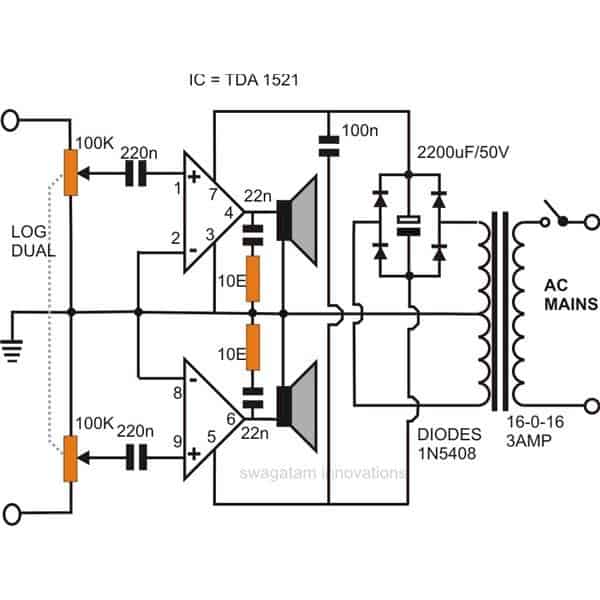A simple stereo audio amplifier circuit discussed here is built around the IC TDA 1521, requires very few external passive components and is able to provide a powerful 12 + 12 watts of music output.
Main Features of the Stereo Amplifier IC
The IC contains all the built in features required for an amplifier circuit like automatic mute, overload and over heat protections.
The circuit of a stereo audio amplifier using IC TDA 1521 presented here is very simple to build, utilizes very few external components and yet is able to produce 12 + 12 watts of hi-fi music power.
The input can be from a CD player or your cell phone. Building a stereo audio amplifier usually refers to using two mono amplifiers and integrating their inputs, common ground and the supply to get the required stereo provisions.
However such circuits generally tend to become too bulky and moreover making identical modules simply makes everything double and thus the costs involved also get doubled.
But there are quite a few single chips available in the market which contains built-in dual amplifier blocks to make things really compact and sleek.
One such IC is the TDA1521 which is a dual high fidelity power amplifier chip embedded inside a 9-pin plastic encapsulation.
The chip is perfectly suited to be used with rough power supplies and indeed has rugged specifications.
How to Build the Amplifier Circuit
We will discuss how to make a simple stereo amplifier using this IC, but before that let’s first go through some interesting specifications of this device.
The TDA1521 basically produces optimum performance with dual supply voltages of around 16 volts and will deliver a good 2 to 12 watts of music thrust into a couple of 8 Ohms loud speakers.
The gain of the amplifier is internally calibrated and fixed at 30 dB with a space of 0.2 dB. This ensures a nice balance of gain in between its two channels.
The chip carries a special in-built music mute facility. The feature enables the IC to disconnect its non-inverting inputs when the supply falls below +/- 6 volts, although the amplifier remains successfully biased at this voltage.
The above property makes the circuit free from unnecessary clicking noises while switching the circuit ON and OFF.
Short Circuit and Overload Protection
The output of the IC is well protected against overloads and accidental short circuits.
The IC also includes a thermal runaway protection so that excessive heating of the IC will not damage it; however it may shut-off at high case temperatures.
Therefore it is recommended that the IC is fixed with a heatsink rated at 4K/W when the output is subjected to a 8 Ohm load @ +/- 16 volts supply.
Please note that the pin #5 of the IC is internally linked with the external metal tab over the IC.

Parts List
- Resistors are 1/4 watt 5% CFR
- 10 Ω = 2
- Potentiometer 100 k = 2
- Capacitors are PPC 100 V, unless specified.
- 220 nF = 2
- 22 nF = 2
- 100 nF = 1
- Electrolytic 2200 µF / 50 V = 1
- Bridge rectifier diodes 1N5402 = 4
- Transformer 16-0-16V 3 amp = 1
- Loudspeaker 20 watts 8 ohm = 2
Technical Specifications
The following data provides a few interesting specifications accompanied with this stereo amplifier chip:
- Total Harmonic Distortion: 0.5% @ 12 watts,
- Quiscent Current Drain is less than 40 mA,
- Gain Balance is around 0.2 dB,
- Supply Ripple Rejection is around 60 dB,
- Channel Separation is @ 70 dB,
- Output Offset Voltage is 20 mV,
- Power Bandwidth (@3 dB) is 20 to 20000 Hz.
Circuit Operation:
The stereo amplifier circuit shown is quite simple and is almost self explanatory.
As you can see this stereo audio amplifier hardly requires any components to become a full fledged stereo amplifier.
Just a resistor/ capacitor network to handle frequency compensation and a couple of input DC blocking capacitors is all that is needed to generate high quality stereo music from this little package….amazing indeed.
The whole unit of this stereo audio amplifier can be easily built over a general purpose board and the whole system along with the power supply may be enclosed inside a sturdy metallic box.
Whether it’s your CD player or your cell phone, it will convert every bit of it into a heart throbbing true pulsating stereo output.